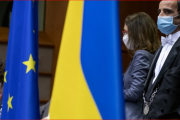It was just a few days after the ban on visits to his mother’s nursing home in the Swedish city of Uppsala, on 3 April, that Magnus Bondesson started to get worried.
“They [the home] opened up for Skype calls and that’s when I saw two employees. I didn’t see any masks and they didn’t have gloves on,” says Bondesson, a start-up founder and app developer.
“When I called again a few days later I questioned the person helping out, asking why they didn’t use face masks, and he said they were just following the guidelines.”
That same week there were numerous reports in Sweden’s national news media about just how badly the country’s nursing homes were starting to be hit by the coronavirus, with hundreds of cases confirmed at homes in Stockholm, the worst affected region, and infections in homes across the country.
Since then pressure has mounted on the government to explain how, despite a stated aim of protecting the elderly from the risks of Covid-19, a third of fatalities have been people living in care homes.
Last week, as figures released by the Public Health Agency of Sweden indicated that 1,333 people had now died of coronavirus, the country’s normally unflappable state epidemiologist Anders Tegnell admitted that the situation in care homes was worrying.
“This is our big problem area,” said Tegnell, the brains behind the government’s relatively light-touch strategy, which has seen it ask, rather than order, people to avoid non-essential travel, work from home and stay indoors if they are over 70 or are feeling ill.
The same day prime minister Stefan Löfven said that the country faced a “serious situation” in its old people’s homes, announced efforts to step up protections, and ordered the country’s health inspectorate to investigate.
Lena Einhorn, a virologist who has been one of the leading domestic critics of Sweden’s coronavirus policy, told the Observer that the government and the health agency were still resisting the most obvious explanations.
“They have to admit that it’s a huge failure, since they have said the whole time that their main aim has been to protect the elderly,” she said. “But what is really strange is that they still do not acknowledge the likely route. They say it’s very unfortunate, that they are investigating, and that it’s a matter of the training personnel, but they will not acknowledge that presymptomatic or asymptomatic spread is a factor.”
The agency’s advice to those managing and working at nursing homes, like its policy towards coronavirus in general, has been based on its judgment that the “spread from those without symptoms is responsible for a very limited share” of those who get infected.
Its advice to the care workers and nurses looking after older people such as Bondesson’s 69-year-old mother is that they should not wear protective masks or use other protective equipment unless they are dealing with a resident in the home they have reason to suspect is infected.
Otherwise the central protective measure in place is that staff should stay home if they detect any symptoms in themselves.
“Where I’m working we don’t have face masks at all, and we are working with the most vulnerable people of all,” said one care home worker, who wanted to remain anonymous. “We don’t have hand sanitiser, just soap. That’s it. Everybody’s concerned about it. We are all worried.”
“The worst thing is that it is us, the staff, who are taking the infection in to the elderly,” complained one nurse to Swedish public broadcaster SVT. “It’s unbelievable that more of them haven’t been infected. It’s a scandal.”
Einhorn was one of 22 researchers who on Tuesday called for Sweden’s politicians to break with the country’s tradition of entrusting policy to its expert agencies, and to seize control of Sweden’s coronavirus strategy from the agency.
She argues that the reason why Sweden has a much higher number of cases in care homes than in Norway and Finland is not because of the homes themselves, but because of Sweden’s decision to keep schools and kindergartens open, and not to shut restaurants or bars.
“It’s not like it goes from one old age home to another. It comes in separately to all of these old age homes, so there’s no way it can be all be attributed to the personnel going in and working when they are sick. There’s a basic system fault in their recommendations. There’s no other explanation for it.”
Tegnell’s colleague AnnaSara Carnahan on Friday told Sveriges Radio that the number of deaths reported from old people’s homes was “probably an underestimate”, as regional health infectious diseases units were reporting that many elderly who died were not being tested.
Bondesson’s mother, who has dementia, is worried, he says. “She is aware of most things that you talk about, it’s just that she might have bad short-term memory, on and off,” he said. “She had also been questioning the lack of face masks. She thinks it’s really sad to have to be there constantly for weeks and not to know when it’s going to end.”







































admin in: How the Muslim Brotherhood betrayed Saudi Arabia?
Great article with insight ...
https://www.viagrapascherfr.com/achat-sildenafil-pfizer-tarif/ in: Cross-region cooperation between anti-terrorism agencies needed
Hello there, just became aware of your blog through Google, and found ...